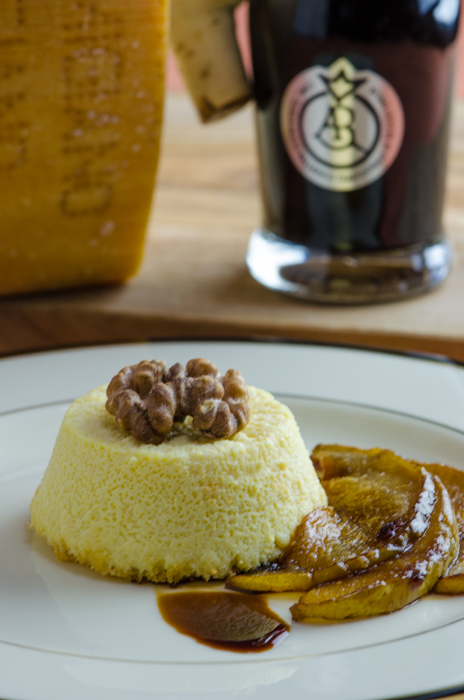 We indulge in many wonderful Italian specialties with guests on our private walking and cycling tours in Italy, but one that always generates lots of discussion is Parmigiano Reggiano cheese – primarily because it can be found back home in the US and our guests want to be educated consumers when they return. What is it? What do I look for when I buy it? Is there a good substitute? Can I buy some here and bring it home? I’ll address a few of this questions here, and finish with an easy and elegant recipe featuring the “King of Cheeses”. I reference Lynn Rossetto Kaspers’s “The Splendid Table” for some of the following information.
We indulge in many wonderful Italian specialties with guests on our private walking and cycling tours in Italy, but one that always generates lots of discussion is Parmigiano Reggiano cheese – primarily because it can be found back home in the US and our guests want to be educated consumers when they return. What is it? What do I look for when I buy it? Is there a good substitute? Can I buy some here and bring it home? I’ll address a few of this questions here, and finish with an easy and elegant recipe featuring the “King of Cheeses”. I reference Lynn Rossetto Kaspers’s “The Splendid Table” for some of the following information.
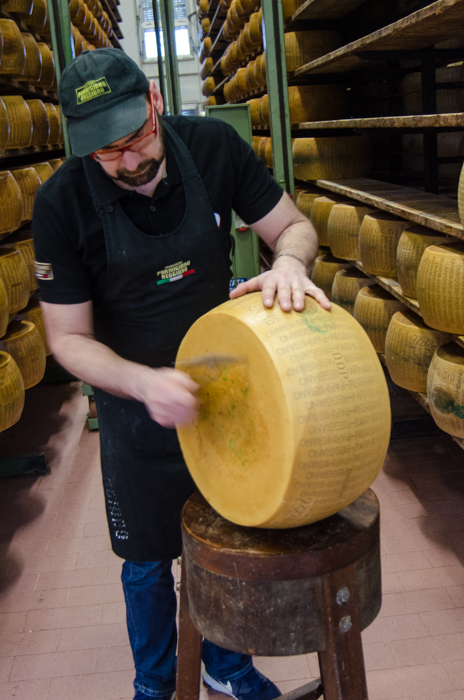
What is Parmigiano Reggiano cheese?
It is a part skim cow’s milk cheese, aged 18 months to 4 years or more. Production is limited to the Italian province of Emilia and a small part of Lombardy. It is a grana (grain) style cheese, a generic term for aged Italian hard cheese whose interiors are speckled with grain-shaped white flecks of crystallized amino acids that often crackle in the mouth. For the details of the production process and quality controls, see my recent article covering my visit to a producer of Parmigiano Reggiano in Parma.
What do I look for when I buy it in the US?
The identity of Parmigiano Reggiano cheese for sale here in the US is confusing, as it is widely imitated, typically very poorly. There is ONLY one type of Parmigiano Reggiano cheese, and this comes from the aforementioned regions in Italy. It is not produced here is the US. It does not come pre-grated in a green can. It is not sold as “Parmesan” cheese.
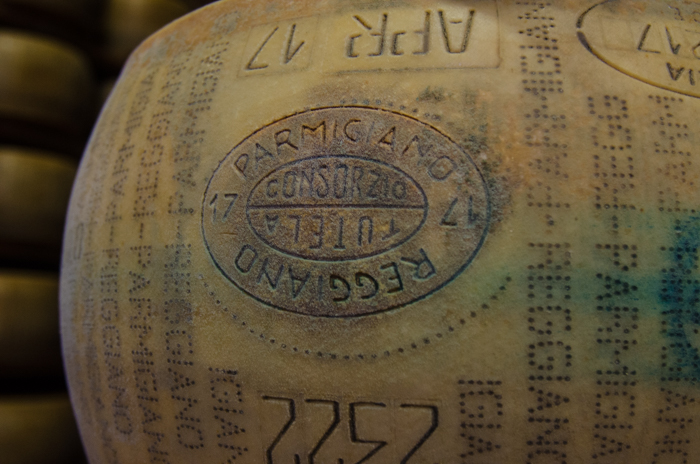
You can find true imported Parmigiano Reggiano cheese at specialty grocers. It is made only in large 800 lb. wheels, so the wheel itself may not be on the premises. It will be broken up into smaller pieces, and wrapped tightly in plastic wrap, or cheese paper if it is cut at purchase. It will not be sold already grated; it should never be grated until you are ready to use. Look for the words PARMIGIANO REGGIANO to be marked repeatedly on the rind; this unique stencil is tightly controlled by the producers and identifies the authentic product.
It is unlikely you will find a store here in the US that offers more than one option as to the age of the Parmigiano Reggiano cheese; typically here I find 18 month or 24 month.
Store in the refrigerator, it will keep for about a month.
Is there a good substitute?
Of course, true aficionados will say “No!” But a nice imported “grana” cheese will do for most culinary uses, like Grana Padano. This cheese goes through a very similar production process, but is not from the authorized producers in the provinces of Emilia and Lombardy. However, I would save my 25 year old bottle of Traditional Balsamic Vinegar from Reggio Emilia for the real stuff.
Can I buy some in Italy and bring it home?
Yes, Customs allows you to bring home hard and semi-hard cheeses. You can find the cheeses already vacuum packed, they will keep 3 months like this. A hard, aged cheese like Parmigiano Reggiano will be fine unrefrigerated in your luggage for the day you will travel. Just make sure to declare to Customs, it is not worth risking the hefty fine. You may want to make sure it is easily accessible in your luggage should they wish to inspect.
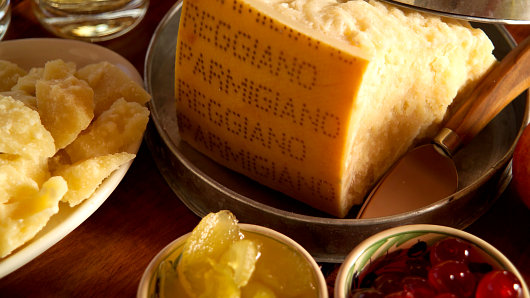
In Italy, you will have the option of purchasing Parmigiano Reggiano cheese of different ages – 18 month, 24 month, 30 month, even 48 month; you can take home a few to compare the differences. Older is not always better, an Italian nonna would recommend a younger cheese, which will have a more delicate flavor, as part of an antipasti, accompanied by raw vegetables, fresh fruit, or paired with a mild fruit or fig jam. A 24-month old Parmigiano Reggiano is best grated on traditional Italian pasta dishes or soups, or served with nuts and dried fruit. A 26 to 30-month old Parmigiano Reggiano would be used to enhance flavor of main courses, served as shavings on meat with a drizzle of extra-virgin olive oil. The ultimate indulgence is to pair the most exclusive 48 month aged with a few drops of the thick, luscious Traditional Balsamic Vinegar from Modena or Reggio Emilia.
The Parmigiano Reggiano consortium offers a nice array of recipes on its web site. It includes a recipe for a cheese souffle, elegant, but intimidating! A sformato is similar to a soufflé, but is not as airy, with no risk that it will deflate. Italians will also use the French word flan for this type of preparation.
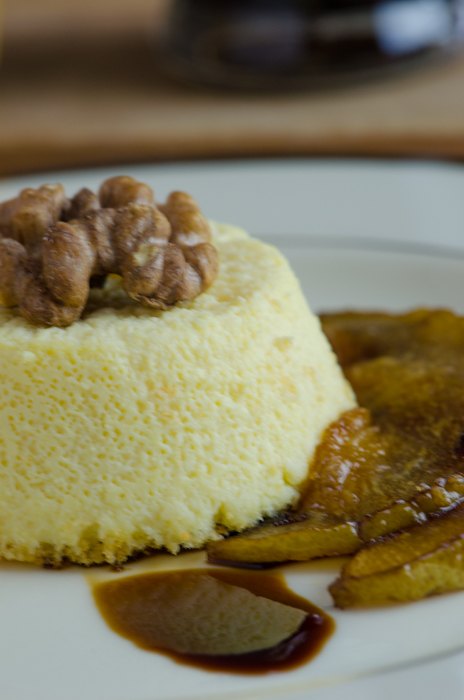
Sformato di Parmigiano with Caramelized Pears
Adapted from “Eating My Way Through Italy” by Elizabeth Minchilli
Serves 10
2 tablespoons butter
1 cup heavy cream
3 1/2 ounces 24- to 30-month-old Parmigiano Reggiano cheese, finely grated
4 large eggs
1 ripe, but firm, pear, thinly sliced
2 tablespoons granulated sugar
2 tablespoons of Aceto Balsamico di Modena
Aceto Balsamico Tradizionale for drizzling
Ten 1/2-cup molds or muffin cups
Preheat the oven to 325°F. Butter the interior of the molds or muffin cups.
Put the heavy cream and eggs in a large bowl, whisk to combine. Add the grated Parmigiano Reggiano, whisk until smooth.
Divide the mixture among the buttered molds and place them in a large roasting pan, filling it halfway up with very hot water.
Place the pan in the oven and bake for 45 minutes, until the sformato are set – they don’t wiggle when you shake them – and they are lightly browned. Remove from oven and allow to cool.
Heat a non-stick frying pan over medium-high heat. Add 2 tablespoons of water and add the pears. As soon as they begin to brown, sprinkle them with the sugar, turn them over, and cook them on the opposite side.
Reduce the heat to medium. Drizzle with 2 tablespoons of the Aceto Balsamico di Modena and let it evaporate. Remove from heat.
Run a knife around each between the mold and the sformato to loosen the sformato. Invert the sformato onto individual serving plates. Arrange a few slices of pear next to each. Drizzle with Aceto Balsamico Tradizionale.
